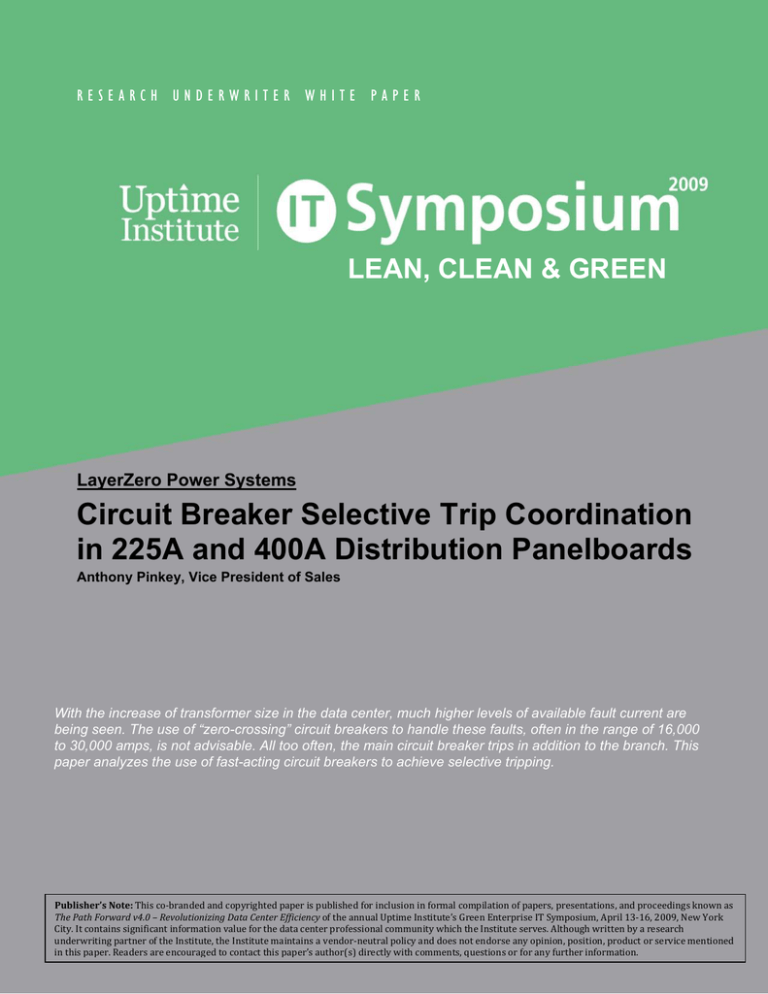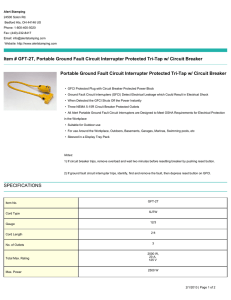
RESEARCH UNDERWRITER WHITE PAPER
LEAN, CLEAN & GREEN
LayerZero Power Systems
Circuit Breaker Selective Trip Coordination
in 225A and 400A Distribution Panelboards
Anthony Pinkey, Vice President of Sales
With the increase of transformer size in the data center, much higher levels of available fault current are
being seen. The use of “zero-crossing” circuit breakers to handle these faults, often in the range of 16,000
to 30,000 amps, is not advisable. All too often, the main circuit breaker trips in addition to the branch. This
paper analyzes the use of fast-acting circuit breakers to achieve selective tripping.
Publisher’s Note: This co‐branded and copyrighted paper is published for inclusion in formal compilation of papers, presentations, and proceedings known as The Path Forward v4.0 – Revolutionizing Data Center Efficiency of the annual Uptime Institute’s Green Enterprise IT Symposium, April 13‐16, 2009, New York City. It contains significant information value for the data center professional community which the Institute serves. Although written by a research underwriting partner of the Institute, the Institute maintains a vendor‐neutral policy and does not endorse any opinion, position, product or service mentioned in this paper. Readers are encouraged to contact this paper’s author(s) directly with comments, questions or for any further information.
UPTIME INSTITUTE RESEARCH UNDERWRITER WHITE PAPER Circuit Breaker Selective Trip Coordination
Introduction
rated transformers have disrupted the selective trip
coordination that was trouble free for many years.
A properly designed electrical distribution system
coordinates all circuit breakers for circuit breaker selective
tripping. Selective tripping is defined as: When a fault
occurs anywhere in the distribution system, one and only
one breaker will trip. That breaker should always be
situated upstream and closest to the fault. There should be
no other circuit breakers between the tripped breaker and
the fault.
In data center distribution panelboards, the Main Circuit
Breaker (MCB) feeds up to 42 branch circuit breakers.
Each branch circuit breaker feeds its own customer-defined
item of mission critical load. MCBs are rated 225A or
400A, whereas branch circuit breakers are typically rated
from 10A to 100A. As outlined above, in a properly
coordinated system for selective tripping, if a fault occurs
on the load side of the branch breaker, it is expected that
the branch circuit breaker will open and clear the fault
before the MCB opens. (See Figure 1.)
Recognizing The Problem: Circuit Breakers Are
Not Coordinated Properly
To understand why tripping selectivity has been lost under
the conditions described above, we must examine the
respective fault conditions and responses to that fault. The
phase-to-ground short circuit current sourced by a 125kVA,
3.5 percent impedance transformer with a 208V secondary
is
Ik =
125000
0.035 3 ⋅ 208
= 9925 Amps,
so
the available fault current is therefore 9,925 amps.
All thermal-magnetic circuit breakers have two ratings:
overload and instantaneous. It is the instantaneous rating
that must handle the 9,925A of available fault current.
Once the available fault current is calculated, a
coordination study needs to be initiated so the circuit
breaker closest to the fault will 1) be able to withstand the
fault, and 2) open the circuit before any upstream circuit
breaker opens. Using a branch breaker with an
instantaneous rating of 10,000Amps Interrupting Capacity
(AIC) was sufficient for the past 30 years.
History: A Change In Transformers Affects
Mission Critical Systems
During the ‘80s, ‘90s and early 2000’s, power distribution
transformers in the data center were generally rated up to
125kVA. The downstream circuit breakers coordinated
properly and there were no coordination problems. By
2005, the use of high power density loads created a demand
for more power. The result was the introduction of
225kVA and 300kVA transformers on the data center floor.
Today, a 300kVA transformer with 3.5 percent impedance
rating has replaced the 125kVA model. Using the same
calculations, this transformer has the ability to sustain
23,820 amps of fault current on its secondary side. All
downstream circuit breakers must therefore be able to clear
a 23,820 amp fault. However, the branch breakers being
supplied are still of the 10,000AIC design, clearly not
A consequence of this introduction is that main circuit
breakers trip instead of or in addition to the branch breaker
feeding the downstream fault. (See Figure 2.) The higher
2
UPTIME INSTITUTE RESEARCH UNDERWRITER WHITE PAPER Circuit Breaker Selective Trip Coordination
The longer a branch circuit breaker is required to conduct a
fault current, all of the other branch breakers on the
panelboard and their critical loads experience equivalent
electrical quality effects. It is imperative that the branch
circuit breaker interrupt the fault current as fast as possible.
capable of clearing a fault of this magnitude. There is room
for significant confusion here. Manufacturers state that the
main breaker (225A or 400A) is rated for 22 kAIC and that
the branch breakers are series-rated for 22kAIC. A seriesrating, as described, is for safety only. A series safetyrating means that the main breaker will protect the branch
breakers in the event that the branch breaker cannot handle
the available fault current. In this case, the main breaker
will trip open to protect the branch breaker from fire or
explosion. A series rating for safety does not state anything
about the ability to selectively trip when the fault occurs
downstream of the branch breaker.
Solution
The use of a current-limiting branch circuit breaker is the
clear solution to this design dilemma. A current-limiting
branch circuit breaker does not require waiting 8-9 milli
seconds (ms) until the fault current goes to zero. It is
engineered to selectively trip up to 35kAIC. Instead of
wrapping the instantaneous coil around the bimetal, the two
components are separated. (See Figure 4.) A linear
magnetic motor opens a set of contacts within 1ms. The
resulting ionized gasses are vented through arc chutes and
the fault current is reduced and cleared in approximately 2
ms. (See Figure 5.)
Zero-crossing Circuit Breaker Design Is Not
Sufficient
In a thermal-magnetic circuit breaker, a bimetal,
temperature-operative element is used to react to slow
overloads and an instantaneous magnetic coil is used to
react to fault currents. There is no means to extinguish
current flow through the arc that begins when the contacts
separate and the next current zero crossing. Hence the term:
“Zero-Crossing Breaker”; it has to sit there and look at the
fault until it extinguishes itself. It has been reported that a
zero-crossing branch circuit breaker rated at 10,000 AIC, in
series with the MCB, will be able to provide selectivity of
tripping if the available fault current is less than about
6,000A. If the fault current is 6,000A or below, the branch
breaker will successfully open before the MCB and be
coordinated for selective tripping. However, if the
available fault current is above 6,000A, the main circuit
breaker will trip before the branch to successfully protect it
(and avoid a fire or explosion). However, this operation
results in loss of power to the entire panel board load. (See
Figure 3.)
3
UPTIME INSTITUTE RESEARCH UNDERWRITER WHITE PAPER Circuit Breaker Selective Trip Coordination
Instantaneous Trip Coil
Conclusion
place increasing coordination pressure on all downstream
protective devices.
The trend toward higher power density designs in modern
data centers has created new difficulties in establishing
proper circuit breaker coordination. Higher capacity power
distribution transformers with lower per-unit impedance
When prospective fault current levels reach 6,000 Amps
root-mean-squared (ARMS) symmetrical, it becomes nearly
impossible to design effective coordination through the
4
UPTIME INSTITUTE RESEARCH UNDERWRITER WHITE PAPER Circuit Breaker Selective Trip Coordination
panelboard branch circuit protective devices using
traditional circuit breakers. The central dilemma is that
traditional branch circuit breakers allow too much fault
current to flow before disconnecting the fault. This
excessive fault current does not permit proper coordination
with the 225ARMS or 400ARMS upstream panelboard main
or subfeed distribution circuit breakers.
LayerZero’s STS; PDU and RPP products lead the industry
with innovations like Waveform Capture; Triple Modular
Redundancy; Inrush Mitigation; Finger Safe distribution
panel boards; and Selective Trip Coordination.
Selective trip operation via proper coordination is
achievable at very high prospective fault current levels by
using current limiting (fast acting) branch circuit breakers.
These protective components provide the necessary
limitation of equivalent normalized energy to remove the
fault from the system before the upstream panel board main
or subfeed distribution circuit breakers reach the inside
boundary of their instantaneous trip range. This fast action
reduces the amount of time that all critical circuits (up to
42) on the mission critical bus are exposed to the problem.
Current limiting branch circuit breakers substantially ease
the coordination design process, improve overall system
reliability and yield measurable uptime improvement for
the mission critical facility end user.
Uptime Institute is a leading global authority on data
centers. Since 1993, it has provided education, consulting,
knowledge networks, and expert advisory for data center
Facilities and IT organizations interested in maximizing
site infrastructure uptime availability. It has pioneered
numerous industry innovations, including the Tier
Classification System for data center availability, which
serves as a de facto industry standard. Site Uptime Network
is a private knowledge network with 100 global corporate
and government members, mostly at the scale of Fortune
100-sized organizations in North America and EMEA. In
2008, the Institute launched an individual Institute
membership program. For the industry as a whole, the
Institute certifies data center Tier level and site resiliency,
provides site sustainability assessments, and assists data
center owners in planning and justifying data center
projects. It publishes papers and reports, offers seminars,
and produces an annual Green Enterprise IT Symposium,
the premier event in the field focused primarily on
improving enterprise IT and data center computing energy
efficiency. It also sponsors the annual Green Enterprise IT
Awards and the Global Green 100 programs. The Institute
conducts custom surveys, research and product
certifications for industry manufacturers. All Institute
published materials are © 2009 Uptime Institute, Inc., and
protected by international copyright law, all rights reserved,
for all media and all uses. Written permission is required to
reproduce all or any portion of the Institute’s literature for
any purpose. To download the reprint permission request
form, uptimeinstitute.org/resources.
About the Uptime Institute
About the Author
Anthony Pinkey is Vice-President of Sales for LayerZero
Power Systems, Inc. Born, raised and educated in New
York City, he holds a bachelor’s degree in Electrical and
Electronics Engineering in the Nuclear Science Sequence
from Manhattan College.
Over 25 years in the mission critical power distribution
industry, he has held various positions in product
management, sales, and marketing. Anthony has
represented the United States playing rugby in 10 countries.
For more information about this paper or LayerZero Power
Systems, please contact apinkey@layerzero.com.
Uptime Institute, Inc.
2904 Rodeo Park Drive East
Building 100
Santa Fe, NM 87505-6316
Corporate Offices: 505.986.3900
Fax: 505.982.8484
uptimeinstitute.org
© 2009 Uptime Institute, Inc. and LayerZero
Power Systems, Inc.
About LayerZero Power Systems
Founded in 2001, LayerZero Power Systems, Inc. is built
on the vision of creating outstanding value and transferring
this value to its mission critical customers; its talented
employees; and its resourceful suppliers. LayerZero has
established an industry leadership position in providing
products with four salient attributes: Operator Safety;
Critical Load Reliability; Information Centricity; and
Ethernet based Open Connectivity.
5



